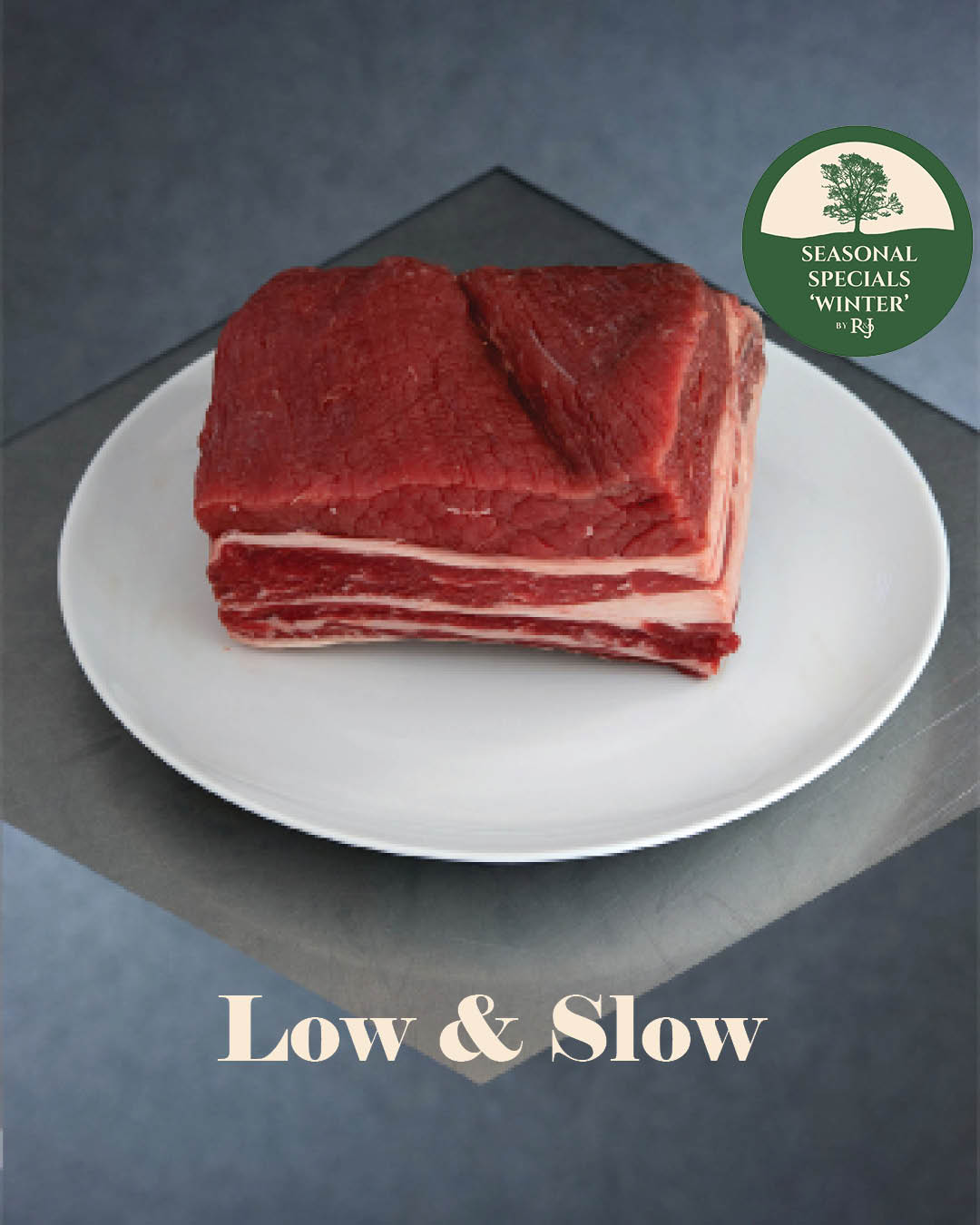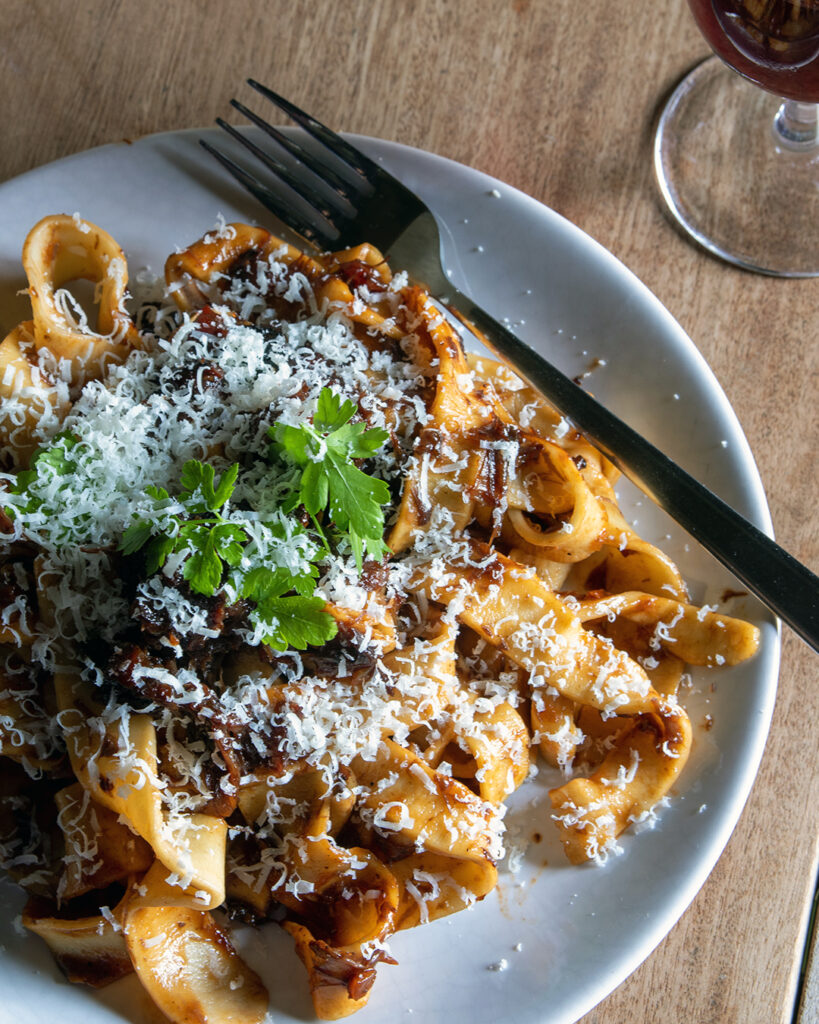October 9, 2023
Low & Slow

As the weather turns and the nights draw in, we begin to crave warming foods and naturally our seasonal palates move on to rich, steaming stews, ragus and slow roasts. All of these are cooked using a method we call ‘Low and Slow’ which as the name suggests, means cooking over a long period at a steady, low temperature.
There is something so nourishing and reassuringly comforting about the deep flavours and juicy melt-in-the-mouth meat that is the result of slow cooking, that the magic of Low & Slow is well worth exploring. We say magic as in many cases this method allows the meat to completely transform from the seemingly hard to cook, tough or less popular cuts into a mouthwatering masterpiece that literally falls softly off the bone.
How does something so simple to create taste so good? Here we look at the science behind slow cooking, its many virtues and discuss the best cuts of meat to use and why. We hope to provide you with some ideas and inspiration that will expand your culinary repertoire and have you positively relishing the prospect of cold, dark winter nights!
The science behind ‘Low & Slow’
What we consume as meat is usually the muscle of the animal, made up of connective tissue known as the protein collagen. Cooking low (temperatures between 90-170 degrees celsius) and slow (over a period of two to five hours or longer) allows the heat to radiate evenly through the meat. The collagen in the muscle breaks down into soft, silky gelatin and the fat slowly melts, retaining moisture in the meat and resulting in that wonderful fall-apart texture and enhancing the deep, rich flavour.
The many virtues of slow cooking
It’s easy – Slow cooking requires little preparation and very little effort. You can let the oven or slow cooker do all the work. Once all the ingredients are prepared, they can be placed into the pot with plenty of liquid. Seal with a tight fitting lid or foil and allow the flavours to blend and mingle together over time. A truly delicious result without any of the faffing or fuss. If you have the time and the patience you will be richly rewarded for making very little effort, and using very little kitchen kit, therefore minimising washing up. What’s not to love about that!
It’s versatile – Think one-pot meals, stews, braises, slow roasts, ragus and tagines. Impressive enough for friends and family coming for lunch on Sunday, but also perfect for an easy mid-week supper. Beef, lamb, pork, poultry or rabbit are all suitable for slow cooking, depending on the cut (see below). Experiment with different flavours to form the basis of your sauce using enhancers such as herbs, spices, garlic and tomato puree. A variety of your preferred vegetables can be thrown in the pot (onions, carrots, leeks, celeriac work well – use what’s in season) as well as good stock, wine or tinned tomatoes to provide plenty of liquid.
It’s budget friendly – whether you’re entertaining large numbers or batch cooking family meals for the freezer, there are ways to be thrifty when it comes to slow cooking. Generally speaking the cuts that are best suited tend to be more economical, and the cheaper varieties of root vegetables are also ideal. Beef brisket, braising steak and shin suit well and are easier on a frugal budget yet can be equally as delicious as the more expensive prime cuts.
General consensus is that cooking low and slow also uses far less fuel or energy. A slow cooker is more energy efficient than an oven, even though it may be on for longer. Batch cooking large amounts using the low and slow method will save you both time and money. It’s a win win.
It’s sustainable – as nose-to-tail butchers we are always conscious of making use of all parts of the animals, leaving very little to waste. It is a delicate balance of making sure we keep up with the demand for more popular prime cuts for our chefs, while making sure we are using the entire beast including the lesser-known parts. The ‘Low & Slow’ cuts are prepared by our expert butchers with just as much care, and as a result we have just as much demand for them from our Chefs as we do for our prime. Our Chefs are very aware of the growing need for sustainability and are skilled at developing new and innovative Low & Slow dishes. Follow our Instagram for more ideas and inspiration from our award-winning chefs.
The best cuts to use and why
While almost any meat will benefit from slow cooking, the best cuts generally come from parts of the animal that do most of the work, so the fore-legs, shoulder, neck and tail even. These cuts will have more connective tissue and are ‘tougher’ as they are working muscles and tend to be higher in fat content and marbling through the joint. In comparison to a cut such as fillet steak, that is very lean and has no connective tissue so can be flashed fried quickly over high heat.

Beef
Ox Cheeks – beef cheeks are beautiful for braising whole or cut into chunks for a stew. Mouthwateringly tender and with an incredible deep flavour, the perfect cut for a long slow braise as they are high in collagen, having worked very hard chewing the cud!
Beef Shin – unctuous and fall apart tender, our Beef Shin Cushions are a boneless medallion shape and sold in a pack of two. Perfect for a mid-week supper or a treat for just the two of you.
Beef Short Rib – otherwise known as Jacob’s Ladder, ideal for braising or slow-cooking on the BBQ or smoker, with ample marbling and layers of beef and sinew that is broken down over the long cooking time.
Lamb
Lamb Shanks – Our Sunday lunch heaven served with buttery mash to soak up the delicious juices. With Autumn lamb at its best now is the time to indulge. Moist, tender and so soft you can eat it with a spoon.
Lamb Breast Boned and Rolled – So versatile, this cut will take you from slow roast perfection with a crispy lamb skin and seasonal veg, to a delicious shredded lamb pitta, served with mint yoghurt and chilli sauce. Made up of brisket and flank of lamb, when slowly rendered the lamb breast flavour is incredible.
Never panic about over-cooking the lamb roast again! A slow roasted shoulder of lamb is very forgiving. Even if it’s in the oven too long it will still be incredibly juicy and full of flavour. We recommend making some small incisions on the skin to insert pieces of garlic and rosemary sprigs to infuse even more flavour. After slowly cooking (four hours or so) the meat will just fall off the bone and can be pulled apart with a fork and spoon, so no need to carve. It doesn’t get an easier!
Pork
Pork Belly – a treat to behold when cooked low and slow. Yorkshire’s Finest Belly Pork comes with the bones removed, but with the all important skin ready to be scored and rubbed with some olive oil and plenty of salt for the ultimate cracking.
Boston Butt – if like us, just the mention of pulled pork gets your mouth watering, then the Boston Butt is for you. The ultimate in slow cooking, show-stopping magnificence. The Boston Butt is ideal for slow cooking on the BBQ with a smoker but can also be done in the oven. The “Butt” cut comes from the shoulder of the pig, not the back end! The joint is left on the blade bone, with the rind removed to allow for a marinade or rub (but kept for crackling.)
All of our ‘Low & Slow’ cuts have further cooking guidance on the individual website pages. In most cases though, it’s the perfect method to experiment with your preferred flavours and not be too worried about timings. You can’t really go wrong and it will always be worth the wait!



Leave a Reply